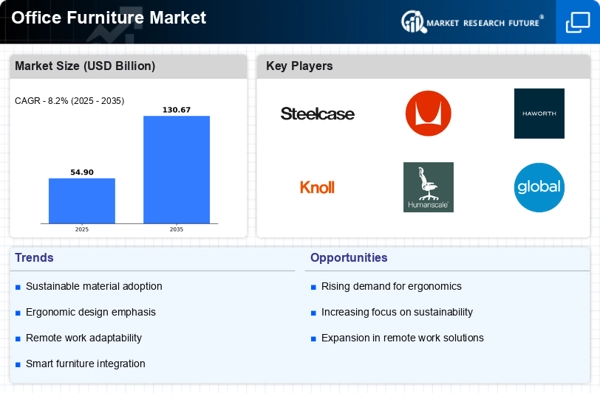-
EXECUTIVE SUMMARY
-
Market Overview
-
Key Findings
-
Market Segmentation
-
Competitive Landscape
-
Challenges and Opportunities
-
Future Outlook
-
\r\n
-
MARKET INTRODUCTION
-
Definition
-
Scope of the study
- Research Objective
- Assumption
- Limitations
-
RESEARCH METHODOLOGY
-
Overview
-
Data Mining
-
Secondary Research
-
Primary Research
- Primary Interviews and Information Gathering Process
- Breakdown of Primary Respondents
-
Forecasting Model
-
Market Size Estimation
- Bottom-Up Approach
- Top-Down Approach
-
Data Triangulation
-
Validation
-
\r\n
-
MARKET DYNAMICS
-
Overview
-
Drivers
-
Restraints
-
Opportunities
-
MARKET FACTOR ANALYSIS
-
Value chain Analysis
-
Porter's Five Forces Analysis
- Bargaining Power of Suppliers
- Bargaining Power of Buyers
- Threat of New Entrants
- Threat of Substitutes
- Intensity of Rivalry
-
COVID-19 Impact Analysis
- Market Impact Analysis
- Regional Impact
- Opportunity and Threat Analysis
-
\r\n
-
OFFICE FURNITURE MARKET, BY PRODUCT TYPE (USD BILLION)
-
Desks
-
Chairs
-
Storage Units
-
Tables
-
Partition Panels
-
OFFICE FURNITURE MARKET, BY MATERIAL (USD BILLION)
-
Wood
-
Metal
-
Plastic
-
Glass
-
OFFICE FURNITURE MARKET, BY END USE (USD BILLION)
-
Corporate Offices
-
Public Sector
-
Educational Institutions
-
Home Offices
-
OFFICE FURNITURE MARKET, BY DISTRIBUTION CHANNEL (USD BILLION)
-
Online Retail
-
Physical Retail
-
Distributors
-
Direct Sales
-
OFFICE FURNITURE MARKET, BY REGIONAL (USD BILLION)
-
North America
- US
- Canada
-
Europe
- Germany
- UK
- France
- Russia
- Italy
- Spain
- Rest of Europe
-
APAC
- China
- India
- Japan
- South Korea
- Malaysia
- Thailand
- Indonesia
- Rest of APAC
-
South America
- Brazil
- Mexico
- Argentina
- Rest of South America
-
MEA
- GCC Countries
- South Africa
- Rest of MEA
-
\r\n
-
COMPETITIVE LANDSCAPE
-
Overview
-
Competitive Analysis
-
Market share Analysis
-
Major Growth Strategy in the Office Furniture Market
-
Competitive Benchmarking
-
Leading Players in Terms of Number of Developments in the Office Furniture Market
-
Key developments and growth strategies
- New Product Launch/Service Deployment
- Merger & Acquisitions
- Joint Ventures
-
Major Players Financial Matrix
- Sales and Operating Income
- Major Players R&D Expenditure. 2023
-
COMPANY PROFILES
-
HNI Corporation
- Financial Overview
- Products Offered
- Key Developments
- SWOT Analysis
- Key Strategies
-
Okamura
- Financial Overview
- Products Offered
- Key Developments
- SWOT Analysis
- Key Strategies
-
Global Industrial
- Financial Overview
- Products Offered
- Key Developments
- SWOT Analysis
- Key Strategies
-
Steelcase
- Financial Overview
- Products Offered
- Key Developments
- SWOT Analysis
- Key Strategies
-
IKEA
- Financial Overview
- Products Offered
- Key Developments
- SWOT Analysis
- Key Strategies
-
Humanscale
- Financial Overview
- Products Offered
- Key Developments
- SWOT Analysis
- Key Strategies
-
BCI Furniture
- Financial Overview
- Products Offered
- Key Developments
- SWOT Analysis
- Key Strategies
-
Herman Miller
- Financial Overview
- Products Offered
- Key Developments
- SWOT Analysis
- Key Strategies
-
Vari
- Financial Overview
- Products Offered
- Key Developments
- SWOT Analysis
- Key Strategies
-
Safco Products
- Financial Overview
- Products Offered
- Key Developments
- SWOT Analysis
- Key Strategies
-
Alera Furniture
- Financial Overview
- Products Offered
- Key Developments
- SWOT Analysis
- Key Strategies
-
Haworth
- Financial Overview
- Products Offered
- Key Developments
- SWOT Analysis
- Key Strategies
-
Knoll
- Financial Overview
- Products Offered
- Key Developments
- SWOT Analysis
- Key Strategies
-
Furnitubes International
- Financial Overview
- Products Offered
- Key Developments
- SWOT Analysis
- Key Strategies
-
Teknion
- Financial Overview
- Products Offered
- Key Developments
- SWOT Analysis
- Key Strategies
-
APPENDIX
-
References
-
Related Reports
-
LIST OF TABLES
-
\r\n
-
LIST OF ASSUMPTIONS
-
NORTH AMERICA OFFICE FURNITURE MARKET SIZE ESTIMATES & FORECAST, BY PRODUCT TYPE, 2019-2035 (USD BILLIONS)
-
NORTH AMERICA OFFICE FURNITURE MARKET SIZE ESTIMATES & FORECAST, BY MATERIAL, 2019-2035 (USD BILLIONS)
-
NORTH AMERICA OFFICE FURNITURE MARKET SIZE ESTIMATES & FORECAST, BY END USE, 2019-2035 (USD BILLIONS)
-
NORTH AMERICA OFFICE FURNITURE MARKET SIZE ESTIMATES & FORECAST, BY DISTRIBUTION CHANNEL, 2019-2035 (USD BILLIONS)
-
NORTH AMERICA OFFICE FURNITURE MARKET SIZE ESTIMATES & FORECAST, BY REGIONAL, 2019-2035 (USD BILLIONS)
-
US OFFICE FURNITURE MARKET SIZE ESTIMATES & FORECAST, BY PRODUCT TYPE, 2019-2035 (USD BILLIONS)
-
US OFFICE FURNITURE MARKET SIZE ESTIMATES & FORECAST, BY MATERIAL, 2019-2035 (USD BILLIONS)
-
US OFFICE FURNITURE MARKET SIZE ESTIMATES & FORECAST, BY END USE, 2019-2035 (USD BILLIONS)
-
US OFFICE FURNITURE MARKET SIZE ESTIMATES & FORECAST, BY DISTRIBUTION CHANNEL, 2019-2035 (USD BILLIONS)
-
US OFFICE FURNITURE MARKET SIZE ESTIMATES & FORECAST, BY REGIONAL, 2019-2035 (USD BILLIONS)
-
CANADA OFFICE FURNITURE MARKET SIZE ESTIMATES & FORECAST, BY PRODUCT TYPE, 2019-2035 (USD BILLIONS)
-
CANADA OFFICE FURNITURE MARKET SIZE ESTIMATES & FORECAST, BY MATERIAL, 2019-2035 (USD BILLIONS)
-
CANADA OFFICE FURNITURE MARKET SIZE ESTIMATES & FORECAST, BY END USE, 2019-2035 (USD BILLIONS)
-
CANADA OFFICE FURNITURE MARKET SIZE ESTIMATES & FORECAST, BY DISTRIBUTION CHANNEL, 2019-2035 (USD BILLIONS)
-
CANADA OFFICE FURNITURE MARKET SIZE ESTIMATES & FORECAST, BY REGIONAL, 2019-2035 (USD BILLIONS)
-
EUROPE OFFICE FURNITURE MARKET SIZE ESTIMATES & FORECAST, BY PRODUCT TYPE, 2019-2035 (USD BILLIONS)
-
EUROPE OFFICE FURNITURE MARKET SIZE ESTIMATES & FORECAST, BY MATERIAL, 2019-2035 (USD BILLIONS)
-
EUROPE OFFICE FURNITURE MARKET SIZE ESTIMATES & FORECAST, BY END USE, 2019-2035 (USD BILLIONS)
-
EUROPE OFFICE FURNITURE MARKET SIZE ESTIMATES & FORECAST, BY DISTRIBUTION CHANNEL, 2019-2035 (USD BILLIONS)
-
EUROPE OFFICE FURNITURE MARKET SIZE ESTIMATES & FORECAST, BY REGIONAL, 2019-2035 (USD BILLIONS)
-
GERMANY OFFICE FURNITURE MARKET SIZE ESTIMATES & FORECAST, BY PRODUCT TYPE, 2019-2035 (USD BILLIONS)
-
GERMANY OFFICE FURNITURE MARKET SIZE ESTIMATES & FORECAST, BY MATERIAL, 2019-2035 (USD BILLIONS)
-
GERMANY OFFICE FURNITURE MARKET SIZE ESTIMATES & FORECAST, BY END USE, 2019-2035 (USD BILLIONS)
-
GERMANY OFFICE FURNITURE MARKET SIZE ESTIMATES & FORECAST, BY DISTRIBUTION CHANNEL, 2019-2035 (USD BILLIONS)
-
GERMANY OFFICE FURNITURE MARKET SIZE ESTIMATES & FORECAST, BY REGIONAL, 2019-2035 (USD BILLIONS)
-
UK OFFICE FURNITURE MARKET SIZE ESTIMATES & FORECAST, BY PRODUCT TYPE, 2019-2035 (USD BILLIONS)
-
UK OFFICE FURNITURE MARKET SIZE ESTIMATES & FORECAST, BY MATERIAL, 2019-2035 (USD BILLIONS)
-
UK OFFICE FURNITURE MARKET SIZE ESTIMATES & FORECAST, BY END USE, 2019-2035 (USD BILLIONS)
-
UK OFFICE FURNITURE MARKET SIZE ESTIMATES & FORECAST, BY DISTRIBUTION CHANNEL, 2019-2035 (USD BILLIONS)
-
UK OFFICE FURNITURE MARKET SIZE ESTIMATES & FORECAST, BY REGIONAL, 2019-2035 (USD BILLIONS)
-
FRANCE OFFICE FURNITURE MARKET SIZE ESTIMATES & FORECAST, BY PRODUCT TYPE, 2019-2035 (USD BILLIONS)
-
FRANCE OFFICE FURNITURE MARKET SIZE ESTIMATES & FORECAST, BY MATERIAL, 2019-2035 (USD BILLIONS)
-
FRANCE OFFICE FURNITURE MARKET SIZE ESTIMATES & FORECAST, BY END USE, 2019-2035 (USD BILLIONS)
-
FRANCE OFFICE FURNITURE MARKET SIZE ESTIMATES & FORECAST, BY DISTRIBUTION CHANNEL, 2019-2035 (USD BILLIONS)
-
FRANCE OFFICE FURNITURE MARKET SIZE ESTIMATES & FORECAST, BY REGIONAL, 2019-2035 (USD BILLIONS)
-
RUSSIA OFFICE FURNITURE MARKET SIZE ESTIMATES & FORECAST, BY PRODUCT TYPE, 2019-2035 (USD BILLIONS)
-
RUSSIA OFFICE FURNITURE MARKET SIZE ESTIMATES & FORECAST, BY MATERIAL, 2019-2035 (USD BILLIONS)
-
RUSSIA OFFICE FURNITURE MARKET SIZE ESTIMATES & FORECAST, BY END USE, 2019-2035 (USD BILLIONS)
-
RUSSIA OFFICE FURNITURE MARKET SIZE ESTIMATES & FORECAST, BY DISTRIBUTION CHANNEL, 2019-2035 (USD BILLIONS)
-
RUSSIA OFFICE FURNITURE MARKET SIZE ESTIMATES & FORECAST, BY REGIONAL, 2019-2035 (USD BILLIONS)
-
ITALY OFFICE FURNITURE MARKET SIZE ESTIMATES & FORECAST, BY PRODUCT TYPE, 2019-2035 (USD BILLIONS)
-
ITALY OFFICE FURNITURE MARKET SIZE ESTIMATES & FORECAST, BY MATERIAL, 2019-2035 (USD BILLIONS)
-
ITALY OFFICE FURNITURE MARKET SIZE ESTIMATES & FORECAST, BY END USE, 2019-2035 (USD BILLIONS)
-
ITALY OFFICE FURNITURE MARKET SIZE ESTIMATES & FORECAST, BY DISTRIBUTION CHANNEL, 2019-2035 (USD BILLIONS)
-
ITALY OFFICE FURNITURE MARKET SIZE ESTIMATES & FORECAST, BY REGIONAL, 2019-2035 (USD BILLIONS)
-
SPAIN OFFICE FURNITURE MARKET SIZE ESTIMATES & FORECAST, BY PRODUCT TYPE, 2019-2035 (USD BILLIONS)
-
SPAIN OFFICE FURNITURE MARKET SIZE ESTIMATES & FORECAST, BY MATERIAL, 2019-2035 (USD BILLIONS)
-
SPAIN OFFICE FURNITURE MARKET SIZE ESTIMATES & FORECAST, BY END USE, 2019-2035 (USD BILLIONS)
-
SPAIN OFFICE FURNITURE MARKET SIZE ESTIMATES & FORECAST, BY DISTRIBUTION CHANNEL, 2019-2035 (USD BILLIONS)
-
SPAIN OFFICE FURNITURE MARKET SIZE ESTIMATES & FORECAST, BY REGIONAL, 2019-2035 (USD BILLIONS)
-
REST OF EUROPE OFFICE FURNITURE MARKET SIZE ESTIMATES & FORECAST, BY PRODUCT TYPE, 2019-2035 (USD BILLIONS)
-
REST OF EUROPE OFFICE FURNITURE MARKET SIZE ESTIMATES & FORECAST, BY MATERIAL, 2019-2035 (USD BILLIONS)
-
REST OF EUROPE OFFICE FURNITURE MARKET SIZE ESTIMATES & FORECAST, BY END USE, 2019-2035 (USD BILLIONS)
-
REST OF EUROPE OFFICE FURNITURE MARKET SIZE ESTIMATES & FORECAST, BY DISTRIBUTION CHANNEL, 2019-2035 (USD BILLIONS)
-
REST OF EUROPE OFFICE FURNITURE MARKET SIZE ESTIMATES & FORECAST, BY REGIONAL, 2019-2035 (USD BILLIONS)
-
APAC OFFICE FURNITURE MARKET SIZE ESTIMATES & FORECAST, BY PRODUCT TYPE, 2019-2035 (USD BILLIONS)
-
APAC OFFICE FURNITURE MARKET SIZE ESTIMATES & FORECAST, BY MATERIAL, 2019-2035 (USD BILLIONS)
-
APAC OFFICE FURNITURE MARKET SIZE ESTIMATES & FORECAST, BY END USE, 2019-2035 (USD BILLIONS)
-
APAC OFFICE FURNITURE MARKET SIZE ESTIMATES & FORECAST, BY DISTRIBUTION CHANNEL, 2019-2035 (USD BILLIONS)
-
APAC OFFICE FURNITURE MARKET SIZE ESTIMATES & FORECAST, BY REGIONAL, 2019-2035 (USD BILLIONS)
-
CHINA OFFICE FURNITURE MARKET SIZE ESTIMATES & FORECAST, BY PRODUCT TYPE, 2019-2035 (USD BILLIONS)
-
CHINA OFFICE FURNITURE MARKET SIZE ESTIMATES & FORECAST, BY MATERIAL, 2019-2035 (USD BILLIONS)
-
CHINA OFFICE FURNITURE MARKET SIZE ESTIMATES & FORECAST, BY END USE, 2019-2035 (USD BILLIONS)
-
CHINA OFFICE FURNITURE MARKET SIZE ESTIMATES & FORECAST, BY DISTRIBUTION CHANNEL, 2019-2035 (USD BILLIONS)
-
CHINA OFFICE FURNITURE MARKET SIZE ESTIMATES & FORECAST, BY REGIONAL, 2019-2035 (USD BILLIONS)
-
INDIA OFFICE FURNITURE MARKET SIZE ESTIMATES & FORECAST, BY PRODUCT TYPE, 2019-2035 (USD BILLIONS)
-
INDIA OFFICE FURNITURE MARKET SIZE ESTIMATES & FORECAST, BY MATERIAL, 2019-2035 (USD BILLIONS)
-
INDIA OFFICE FURNITURE MARKET SIZE ESTIMATES & FORECAST, BY END USE, 2019-2035 (USD BILLIONS)
-
INDIA OFFICE FURNITURE MARKET SIZE ESTIMATES & FORECAST, BY DISTRIBUTION CHANNEL, 2019-2035 (USD BILLIONS)
-
INDIA OFFICE FURNITURE MARKET SIZE ESTIMATES & FORECAST, BY REGIONAL, 2019-2035 (USD BILLIONS)
-
JAPAN OFFICE FURNITURE MARKET SIZE ESTIMATES & FORECAST, BY PRODUCT TYPE, 2019-2035 (USD BILLIONS)
-
JAPAN OFFICE FURNITURE MARKET SIZE ESTIMATES & FORECAST, BY MATERIAL, 2019-2035 (USD BILLIONS)
-
JAPAN OFFICE FURNITURE MARKET SIZE ESTIMATES & FORECAST, BY END USE, 2019-2035 (USD BILLIONS)
-
JAPAN OFFICE FURNITURE MARKET SIZE ESTIMATES & FORECAST, BY DISTRIBUTION CHANNEL, 2019-2035 (USD BILLIONS)
-
JAPAN OFFICE FURNITURE MARKET SIZE ESTIMATES & FORECAST, BY REGIONAL, 2019-2035 (USD BILLIONS)
-
SOUTH KOREA OFFICE FURNITURE MARKET SIZE ESTIMATES & FORECAST, BY PRODUCT TYPE, 2019-2035 (USD BILLIONS)
-
SOUTH KOREA OFFICE FURNITURE MARKET SIZE ESTIMATES & FORECAST, BY MATERIAL, 2019-2035 (USD BILLIONS)
-
SOUTH KOREA OFFICE FURNITURE MARKET SIZE ESTIMATES & FORECAST, BY END USE, 2019-2035 (USD BILLIONS)
-
SOUTH KOREA OFFICE FURNITURE MARKET SIZE ESTIMATES & FORECAST, BY DISTRIBUTION CHANNEL, 2019-2035 (USD BILLIONS)
-
SOUTH KOREA OFFICE FURNITURE MARKET SIZE ESTIMATES & FORECAST, BY REGIONAL, 2019-2035 (USD BILLIONS)
-
MALAYSIA OFFICE FURNITURE MARKET SIZE ESTIMATES & FORECAST, BY PRODUCT TYPE, 2019-2035 (USD BILLIONS)
-
MALAYSIA OFFICE FURNITURE MARKET SIZE ESTIMATES & FORECAST, BY MATERIAL, 2019-2035 (USD BILLIONS)
-
MALAYSIA OFFICE FURNITURE MARKET SIZE ESTIMATES & FORECAST, BY END USE, 2019-2035 (USD BILLIONS)
-
MALAYSIA OFFICE FURNITURE MARKET SIZE ESTIMATES & FORECAST, BY DISTRIBUTION CHANNEL, 2019-2035 (USD BILLIONS)
-
MALAYSIA OFFICE FURNITURE MARKET SIZE ESTIMATES & FORECAST, BY REGIONAL, 2019-2035 (USD BILLIONS)
-
THAILAND OFFICE FURNITURE MARKET SIZE ESTIMATES & FORECAST, BY PRODUCT TYPE, 2019-2035 (USD BILLIONS)
-
THAILAND OFFICE FURNITURE MARKET SIZE ESTIMATES & FORECAST, BY MATERIAL, 2019-2035 (USD BILLIONS)
-
THAILAND OFFICE FURNITURE MARKET SIZE ESTIMATES & FORECAST, BY END USE, 2019-2035 (USD BILLIONS)
-
THAILAND OFFICE FURNITURE MARKET SIZE ESTIMATES & FORECAST, BY DISTRIBUTION CHANNEL, 2019-2035 (USD BILLIONS)
-
THAILAND OFFICE FURNITURE MARKET SIZE ESTIMATES & FORECAST, BY REGIONAL, 2019-2035 (USD BILLIONS)
-
INDONESIA OFFICE FURNITURE MARKET SIZE ESTIMATES & FORECAST, BY PRODUCT TYPE, 2019-2035 (USD BILLIONS)
-
INDONESIA OFFICE FURNITURE MARKET SIZE ESTIMATES & FORECAST, BY MATERIAL, 2019-2035 (USD BILLIONS)
-
INDONESIA OFFICE FURNITURE MARKET SIZE ESTIMATES & FORECAST, BY END USE, 2019-2035 (USD BILLIONS)
-
INDONESIA OFFICE FURNITURE MARKET SIZE ESTIMATES & FORECAST, BY DISTRIBUTION CHANNEL, 2019-2035 (USD BILLIONS)
-
INDONESIA OFFICE FURNITURE MARKET SIZE ESTIMATES & FORECAST, BY REGIONAL, 2019-2035 (USD BILLIONS)
-
REST OF APAC OFFICE FURNITURE MARKET SIZE ESTIMATES & FORECAST, BY PRODUCT TYPE, 2019-2035 (USD BILLIONS)
-
REST OF APAC OFFICE FURNITURE MARKET SIZE ESTIMATES & FORECAST, BY MATERIAL, 2019-2035 (USD BILLIONS)
-
REST OF APAC OFFICE FURNITURE MARKET SIZE ESTIMATES & FORECAST, BY END USE, 2019-2035 (USD BILLIONS)
-
REST OF APAC OFFICE FURNITURE MARKET SIZE ESTIMATES & FORECAST, BY DISTRIBUTION CHANNEL, 2019-2035 (USD BILLIONS)
-
REST OF APAC OFFICE FURNITURE MARKET SIZE ESTIMATES & FORECAST, BY REGIONAL, 2019-2035 (USD BILLIONS)
-
SOUTH AMERICA OFFICE FURNITURE MARKET SIZE ESTIMATES & FORECAST, BY PRODUCT TYPE, 2019-2035 (USD BILLIONS)
-
SOUTH AMERICA OFFICE FURNITURE MARKET SIZE ESTIMATES & FORECAST, BY MATERIAL, 2019-2035 (USD BILLIONS)
-
SOUTH AMERICA OFFICE FURNITURE MARKET SIZE ESTIMATES & FORECAST, BY END USE, 2019-2035 (USD BILLIONS)
-
SOUTH AMERICA OFFICE FURNITURE MARKET SIZE ESTIMATES & FORECAST, BY DISTRIBUTION CHANNEL, 2019-2035 (USD BILLIONS)
-
SOUTH AMERICA OFFICE FURNITURE MARKET SIZE ESTIMATES & FORECAST, BY REGIONAL, 2019-2035 (USD BILLIONS)
-
BRAZIL OFFICE FURNITURE MARKET SIZE ESTIMATES & FORECAST, BY PRODUCT TYPE, 2019-2035 (USD BILLIONS)
-
BRAZIL OFFICE FURNITURE MARKET SIZE ESTIMATES & FORECAST, BY MATERIAL, 2019-2035 (USD BILLIONS)
-
BRAZIL OFFICE FURNITURE MARKET SIZE ESTIMATES & FORECAST, BY END USE, 2019-2035 (USD BILLIONS)
-
BRAZIL OFFICE FURNITURE MARKET SIZE ESTIMATES & FORECAST, BY DISTRIBUTION CHANNEL, 2019-2035 (USD BILLIONS)
-
BRAZIL OFFICE FURNITURE MARKET SIZE ESTIMATES & FORECAST, BY REGIONAL, 2019-2035 (USD BILLIONS)
-
MEXICO OFFICE FURNITURE MARKET SIZE ESTIMATES & FORECAST, BY PRODUCT TYPE, 2019-2035 (USD BILLIONS)
-
MEXICO OFFICE FURNITURE MARKET SIZE ESTIMATES & FORECAST, BY MATERIAL, 2019-2035 (USD BILLIONS)
-
MEXICO OFFICE FURNITURE MARKET SIZE ESTIMATES & FORECAST, BY END USE, 2019-2035 (USD BILLIONS)
-
MEXICO OFFICE FURNITURE MARKET SIZE ESTIMATES & FORECAST, BY DISTRIBUTION CHANNEL, 2019-2035 (USD BILLIONS)
-
MEXICO OFFICE FURNITURE MARKET SIZE ESTIMATES & FORECAST, BY REGIONAL, 2019-2035 (USD BILLIONS)
-
ARGENTINA OFFICE FURNITURE MARKET SIZE ESTIMATES & FORECAST, BY PRODUCT TYPE, 2019-2035 (USD BILLIONS)
-
ARGENTINA OFFICE FURNITURE MARKET SIZE ESTIMATES & FORECAST, BY MATERIAL, 2019-2035 (USD BILLIONS)
-
ARGENTINA OFFICE FURNITURE MARKET SIZE ESTIMATES & FORECAST, BY END USE, 2019-2035 (USD BILLIONS)
-
ARGENTINA OFFICE FURNITURE MARKET SIZE ESTIMATES & FORECAST, BY DISTRIBUTION CHANNEL, 2019-2035 (USD BILLIONS)
-
ARGENTINA OFFICE FURNITURE MARKET SIZE ESTIMATES & FORECAST, BY REGIONAL, 2019-2035 (USD BILLIONS)
-
REST OF SOUTH AMERICA OFFICE FURNITURE MARKET SIZE ESTIMATES & FORECAST, BY PRODUCT TYPE, 2019-2035 (USD BILLIONS)
-
REST OF SOUTH AMERICA OFFICE FURNITURE MARKET SIZE ESTIMATES & FORECAST, BY MATERIAL, 2019-2035 (USD BILLIONS)
-
REST OF SOUTH AMERICA OFFICE FURNITURE MARKET SIZE ESTIMATES & FORECAST, BY END USE, 2019-2035 (USD BILLIONS)
-
REST OF SOUTH AMERICA OFFICE FURNITURE MARKET SIZE ESTIMATES & FORECAST, BY DISTRIBUTION CHANNEL, 2019-2035 (USD BILLIONS)
-
REST OF SOUTH AMERICA OFFICE FURNITURE MARKET SIZE ESTIMATES & FORECAST, BY REGIONAL, 2019-2035 (USD BILLIONS)
-
MEA OFFICE FURNITURE MARKET SIZE ESTIMATES & FORECAST, BY PRODUCT TYPE, 2019-2035 (USD BILLIONS)
-
MEA OFFICE FURNITURE MARKET SIZE ESTIMATES & FORECAST, BY MATERIAL, 2019-2035 (USD BILLIONS)
-
MEA OFFICE FURNITURE MARKET SIZE ESTIMATES & FORECAST, BY END USE, 2019-2035 (USD BILLIONS)
-
MEA OFFICE FURNITURE MARKET SIZE ESTIMATES & FORECAST, BY DISTRIBUTION CHANNEL, 2019-2035 (USD BILLIONS)
-
MEA OFFICE FURNITURE MARKET SIZE ESTIMATES & FORECAST, BY REGIONAL, 2019-2035 (USD BILLIONS)
-
GCC COUNTRIES OFFICE FURNITURE MARKET SIZE ESTIMATES & FORECAST, BY PRODUCT TYPE, 2019-2035 (USD BILLIONS)
-
GCC COUNTRIES OFFICE FURNITURE MARKET SIZE ESTIMATES & FORECAST, BY MATERIAL, 2019-2035 (USD BILLIONS)
-
GCC COUNTRIES OFFICE FURNITURE MARKET SIZE ESTIMATES & FORECAST, BY END USE, 2019-2035 (USD BILLIONS)
-
GCC COUNTRIES OFFICE FURNITURE MARKET SIZE ESTIMATES & FORECAST, BY DISTRIBUTION CHANNEL, 2019-2035 (USD BILLIONS)
-
GCC COUNTRIES OFFICE FURNITURE MARKET SIZE ESTIMATES & FORECAST, BY REGIONAL, 2019-2035 (USD BILLIONS)
-
SOUTH AFRICA OFFICE FURNITURE MARKET SIZE ESTIMATES & FORECAST, BY PRODUCT TYPE, 2019-2035 (USD BILLIONS)
-
SOUTH AFRICA OFFICE FURNITURE MARKET SIZE ESTIMATES & FORECAST, BY MATERIAL, 2019-2035 (USD BILLIONS)
-
SOUTH AFRICA OFFICE FURNITURE MARKET SIZE ESTIMATES & FORECAST, BY END USE, 2019-2035 (USD BILLIONS)
-
SOUTH AFRICA OFFICE FURNITURE MARKET SIZE ESTIMATES & FORECAST, BY DISTRIBUTION CHANNEL, 2019-2035 (USD BILLIONS)
-
SOUTH AFRICA OFFICE FURNITURE MARKET SIZE ESTIMATES & FORECAST, BY REGIONAL, 2019-2035 (USD BILLIONS)
-
REST OF MEA OFFICE FURNITURE MARKET SIZE ESTIMATES & FORECAST, BY PRODUCT TYPE, 2019-2035 (USD BILLIONS)
-
REST OF MEA OFFICE FURNITURE MARKET SIZE ESTIMATES & FORECAST, BY MATERIAL, 2019-2035 (USD BILLIONS)
-
REST OF MEA OFFICE FURNITURE MARKET SIZE ESTIMATES & FORECAST, BY END USE, 2019-2035 (USD BILLIONS)
-
REST OF MEA OFFICE FURNITURE MARKET SIZE ESTIMATES & FORECAST, BY DISTRIBUTION CHANNEL, 2019-2035 (USD BILLIONS)
-
REST OF MEA OFFICE FURNITURE MARKET SIZE ESTIMATES & FORECAST, BY REGIONAL, 2019-2035 (USD BILLIONS)
-
PRODUCT LAUNCH/PRODUCT DEVELOPMENT/APPROVAL
-
ACQUISITION/PARTNERSHIP
-
\r\n
-
\r\n
-
\r\n
-
\r\n
-
\r\n
-
\r\n
-
\r\n
-
\r\n
-
\r\n
-
\r\n
-
\r\n
-
\r\n
-
\r\n
-
\r\n
-
\r\n
-
LIST OF FIGURES
-
\r\n
-
MARKET SYNOPSIS
-
NORTH AMERICA OFFICE FURNITURE MARKET ANALYSIS
-
US OFFICE FURNITURE MARKET ANALYSIS BY PRODUCT TYPE
-
US OFFICE FURNITURE MARKET ANALYSIS BY MATERIAL
-
US OFFICE FURNITURE MARKET ANALYSIS BY END USE
-
US OFFICE FURNITURE MARKET ANALYSIS BY DISTRIBUTION CHANNEL
-
US OFFICE FURNITURE MARKET ANALYSIS BY REGIONAL
-
CANADA OFFICE FURNITURE MARKET ANALYSIS BY PRODUCT TYPE
-
CANADA OFFICE FURNITURE MARKET ANALYSIS BY MATERIAL
-
CANADA OFFICE FURNITURE MARKET ANALYSIS BY END USE
-
CANADA OFFICE FURNITURE MARKET ANALYSIS BY DISTRIBUTION CHANNEL
-
CANADA OFFICE FURNITURE MARKET ANALYSIS BY REGIONAL
-
EUROPE OFFICE FURNITURE MARKET ANALYSIS
-
GERMANY OFFICE FURNITURE MARKET ANALYSIS BY PRODUCT TYPE
-
GERMANY OFFICE FURNITURE MARKET ANALYSIS BY MATERIAL
-
GERMANY OFFICE FURNITURE MARKET ANALYSIS BY END USE
-
GERMANY OFFICE FURNITURE MARKET ANALYSIS BY DISTRIBUTION CHANNEL
-
GERMANY OFFICE FURNITURE MARKET ANALYSIS BY REGIONAL
-
UK OFFICE FURNITURE MARKET ANALYSIS BY PRODUCT TYPE
-
UK OFFICE FURNITURE MARKET ANALYSIS BY MATERIAL
-
UK OFFICE FURNITURE MARKET ANALYSIS BY END USE
-
UK OFFICE FURNITURE MARKET ANALYSIS BY DISTRIBUTION CHANNEL
-
UK OFFICE FURNITURE MARKET ANALYSIS BY REGIONAL
-
FRANCE OFFICE FURNITURE MARKET ANALYSIS BY PRODUCT TYPE
-
FRANCE OFFICE FURNITURE MARKET ANALYSIS BY MATERIAL
-
FRANCE OFFICE FURNITURE MARKET ANALYSIS BY END USE
-
FRANCE OFFICE FURNITURE MARKET ANALYSIS BY DISTRIBUTION CHANNEL
-
FRANCE OFFICE FURNITURE MARKET ANALYSIS BY REGIONAL
-
RUSSIA OFFICE FURNITURE MARKET ANALYSIS BY PRODUCT TYPE
-
RUSSIA OFFICE FURNITURE MARKET ANALYSIS BY MATERIAL
-
RUSSIA OFFICE FURNITURE MARKET ANALYSIS BY END USE
-
RUSSIA OFFICE FURNITURE MARKET ANALYSIS BY DISTRIBUTION CHANNEL
-
RUSSIA OFFICE FURNITURE MARKET ANALYSIS BY REGIONAL
-
ITALY OFFICE FURNITURE MARKET ANALYSIS BY PRODUCT TYPE
-
ITALY OFFICE FURNITURE MARKET ANALYSIS BY MATERIAL
-
ITALY OFFICE FURNITURE MARKET ANALYSIS BY END USE
-
ITALY OFFICE FURNITURE MARKET ANALYSIS BY DISTRIBUTION CHANNEL
-
ITALY OFFICE FURNITURE MARKET ANALYSIS BY REGIONAL
-
SPAIN OFFICE FURNITURE MARKET ANALYSIS BY PRODUCT TYPE
-
SPAIN OFFICE FURNITURE MARKET ANALYSIS BY MATERIAL
-
SPAIN OFFICE FURNITURE MARKET ANALYSIS BY END USE
-
SPAIN OFFICE FURNITURE MARKET ANALYSIS BY DISTRIBUTION CHANNEL
-
SPAIN OFFICE FURNITURE MARKET ANALYSIS BY REGIONAL
-
REST OF EUROPE OFFICE FURNITURE MARKET ANALYSIS BY PRODUCT TYPE
-
REST OF EUROPE OFFICE FURNITURE MARKET ANALYSIS BY MATERIAL
-
REST OF EUROPE OFFICE FURNITURE MARKET ANALYSIS BY END USE
-
REST OF EUROPE OFFICE FURNITURE MARKET ANALYSIS BY DISTRIBUTION CHANNEL
-
REST OF EUROPE OFFICE FURNITURE MARKET ANALYSIS BY REGIONAL
-
APAC OFFICE FURNITURE MARKET ANALYSIS
-
CHINA OFFICE FURNITURE MARKET ANALYSIS BY PRODUCT TYPE
-
CHINA OFFICE FURNITURE MARKET ANALYSIS BY MATERIAL
-
CHINA OFFICE FURNITURE MARKET ANALYSIS BY END USE
-
CHINA OFFICE FURNITURE MARKET ANALYSIS BY DISTRIBUTION CHANNEL
-
CHINA OFFICE FURNITURE MARKET ANALYSIS BY REGIONAL
-
INDIA OFFICE FURNITURE MARKET ANALYSIS BY PRODUCT TYPE
-
INDIA OFFICE FURNITURE MARKET ANALYSIS BY MATERIAL
-
INDIA OFFICE FURNITURE MARKET ANALYSIS BY END USE
-
INDIA OFFICE FURNITURE MARKET ANALYSIS BY DISTRIBUTION CHANNEL
-
INDIA OFFICE FURNITURE MARKET ANALYSIS BY REGIONAL
-
JAPAN OFFICE FURNITURE MARKET ANALYSIS BY PRODUCT TYPE
-
JAPAN OFFICE FURNITURE MARKET ANALYSIS BY MATERIAL
-
JAPAN OFFICE FURNITURE MARKET ANALYSIS BY END USE
-
JAPAN OFFICE FURNITURE MARKET ANALYSIS BY DISTRIBUTION CHANNEL
-
JAPAN OFFICE FURNITURE MARKET ANALYSIS BY REGIONAL
-
SOUTH KOREA OFFICE FURNITURE MARKET ANALYSIS BY PRODUCT TYPE
-
SOUTH KOREA OFFICE FURNITURE MARKET ANALYSIS BY MATERIAL
-
SOUTH KOREA OFFICE FURNITURE MARKET ANALYSIS BY END USE
-
SOUTH KOREA OFFICE FURNITURE MARKET ANALYSIS BY DISTRIBUTION CHANNEL
-
SOUTH KOREA OFFICE FURNITURE MARKET ANALYSIS BY REGIONAL
-
MALAYSIA OFFICE FURNITURE MARKET ANALYSIS BY PRODUCT TYPE
-
MALAYSIA OFFICE FURNITURE MARKET ANALYSIS BY MATERIAL
-
MALAYSIA OFFICE FURNITURE MARKET ANALYSIS BY END USE
-
MALAYSIA OFFICE FURNITURE MARKET ANALYSIS BY DISTRIBUTION CHANNEL
-
MALAYSIA OFFICE FURNITURE MARKET ANALYSIS BY REGIONAL
-
THAILAND OFFICE FURNITURE MARKET ANALYSIS BY PRODUCT TYPE
-
THAILAND OFFICE FURNITURE MARKET ANALYSIS BY MATERIAL
-
THAILAND OFFICE FURNITURE MARKET ANALYSIS BY END USE
-
THAILAND OFFICE FURNITURE MARKET ANALYSIS BY DISTRIBUTION CHANNEL
-
THAILAND OFFICE FURNITURE MARKET ANALYSIS BY REGIONAL
-
INDONESIA OFFICE FURNITURE MARKET ANALYSIS BY PRODUCT TYPE
-
INDONESIA OFFICE FURNITURE MARKET ANALYSIS BY MATERIAL
-
INDONESIA OFFICE FURNITURE MARKET ANALYSIS BY END USE
-
INDONESIA OFFICE FURNITURE MARKET ANALYSIS BY DISTRIBUTION CHANNEL
-
INDONESIA OFFICE FURNITURE MARKET ANALYSIS BY REGIONAL
-
REST OF APAC OFFICE FURNITURE MARKET ANALYSIS BY PRODUCT TYPE
-
REST OF APAC OFFICE FURNITURE MARKET ANALYSIS BY MATERIAL
-
REST OF APAC OFFICE FURNITURE MARKET ANALYSIS BY END USE
-
REST OF APAC OFFICE FURNITURE MARKET ANALYSIS BY DISTRIBUTION CHANNEL
-
REST OF APAC OFFICE FURNITURE MARKET ANALYSIS BY REGIONAL
-
SOUTH AMERICA OFFICE FURNITURE MARKET ANALYSIS
-
BRAZIL OFFICE FURNITURE MARKET ANALYSIS BY PRODUCT TYPE
-
BRAZIL OFFICE FURNITURE MARKET ANALYSIS BY MATERIAL
-
BRAZIL OFFICE FURNITURE MARKET ANALYSIS BY END USE
-
BRAZIL OFFICE FURNITURE MARKET ANALYSIS BY DISTRIBUTION CHANNEL
-
BRAZIL OFFICE FURNITURE MARKET ANALYSIS BY REGIONAL
-
MEXICO OFFICE FURNITURE MARKET ANALYSIS BY PRODUCT TYPE
-
MEXICO OFFICE FURNITURE MARKET ANALYSIS BY MATERIAL
-
MEXICO OFFICE FURNITURE MARKET ANALYSIS BY END USE
-
MEXICO OFFICE FURNITURE MARKET ANALYSIS BY DISTRIBUTION CHANNEL
-
MEXICO OFFICE FURNITURE MARKET ANALYSIS BY REGIONAL
-
ARGENTINA OFFICE FURNITURE MARKET ANALYSIS BY PRODUCT TYPE
-
ARGENTINA OFFICE FURNITURE MARKET ANALYSIS BY MATERIAL
-
ARGENTINA OFFICE FURNITURE MARKET ANALYSIS BY END USE
-
ARGENTINA OFFICE FURNITURE MARKET ANALYSIS BY DISTRIBUTION CHANNEL
-
ARGENTINA OFFICE FURNITURE MARKET ANALYSIS BY REGIONAL
-
REST OF SOUTH AMERICA OFFICE FURNITURE MARKET ANALYSIS BY PRODUCT TYPE
-
REST OF SOUTH AMERICA OFFICE FURNITURE MARKET ANALYSIS BY MATERIAL
-
REST OF SOUTH AMERICA OFFICE FURNITURE MARKET ANALYSIS BY END USE
-
REST OF SOUTH AMERICA OFFICE FURNITURE MARKET ANALYSIS BY DISTRIBUTION CHANNEL
-
REST OF SOUTH AMERICA OFFICE FURNITURE MARKET ANALYSIS BY REGIONAL
-
MEA OFFICE FURNITURE MARKET ANALYSIS
-
GCC COUNTRIES OFFICE FURNITURE MARKET ANALYSIS BY PRODUCT TYPE
-
GCC COUNTRIES OFFICE FURNITURE MARKET ANALYSIS BY MATERIAL
-
GCC COUNTRIES OFFICE FURNITURE MARKET ANALYSIS BY END USE
-
GCC COUNTRIES OFFICE FURNITURE MARKET ANALYSIS BY DISTRIBUTION CHANNEL
-
GCC COUNTRIES OFFICE FURNITURE MARKET ANALYSIS BY REGIONAL
-
SOUTH AFRICA OFFICE FURNITURE MARKET ANALYSIS BY PRODUCT TYPE
-
SOUTH AFRICA OFFICE FURNITURE MARKET ANALYSIS BY MATERIAL
-
SOUTH AFRICA OFFICE FURNITURE MARKET ANALYSIS BY END USE
-
SOUTH AFRICA OFFICE FURNITURE MARKET ANALYSIS BY DISTRIBUTION CHANNEL
-
SOUTH AFRICA OFFICE FURNITURE MARKET ANALYSIS BY REGIONAL
-
REST OF MEA OFFICE FURNITURE MARKET ANALYSIS BY PRODUCT TYPE
-
REST OF MEA OFFICE FURNITURE MARKET ANALYSIS BY MATERIAL
-
REST OF MEA OFFICE FURNITURE MARKET ANALYSIS BY END USE
-
REST OF MEA OFFICE FURNITURE MARKET ANALYSIS BY DISTRIBUTION CHANNEL
-
REST OF MEA OFFICE FURNITURE MARKET ANALYSIS BY REGIONAL
-
KEY BUYING CRITERIA OF OFFICE FURNITURE MARKET
-
RESEARCH PROCESS OF MRFR
-
DRO ANALYSIS OF OFFICE FURNITURE MARKET
-
DRIVERS IMPACT ANALYSIS: OFFICE FURNITURE MARKET
-
RESTRAINTS IMPACT ANALYSIS: OFFICE FURNITURE MARKET
-
SUPPLY / VALUE CHAIN: OFFICE FURNITURE MARKET
-
OFFICE FURNITURE MARKET, BY PRODUCT TYPE, 2025 (% SHARE)
-
OFFICE FURNITURE MARKET, BY PRODUCT TYPE, 2019 TO 2035 (USD Billions)
-
OFFICE FURNITURE MARKET, BY MATERIAL, 2025 (% SHARE)
-
OFFICE FURNITURE MARKET, BY MATERIAL, 2019 TO 2035 (USD Billions)
-
OFFICE FURNITURE MARKET, BY END USE, 2025 (% SHARE)
-
OFFICE FURNITURE MARKET, BY END USE, 2019 TO 2035 (USD Billions)
-
OFFICE FURNITURE MARKET, BY DISTRIBUTION CHANNEL, 2025 (% SHARE)
-
OFFICE FURNITURE MARKET, BY DISTRIBUTION CHANNEL, 2019 TO 2035 (USD Billions)
-
OFFICE FURNITURE MARKET, BY REGIONAL, 2025 (% SHARE)
-
OFFICE FURNITURE MARKET, BY REGIONAL, 2019 TO 2035 (USD Billions)
-
BENCHMARKING OF MAJOR COMPETITORS









Leave a Comment